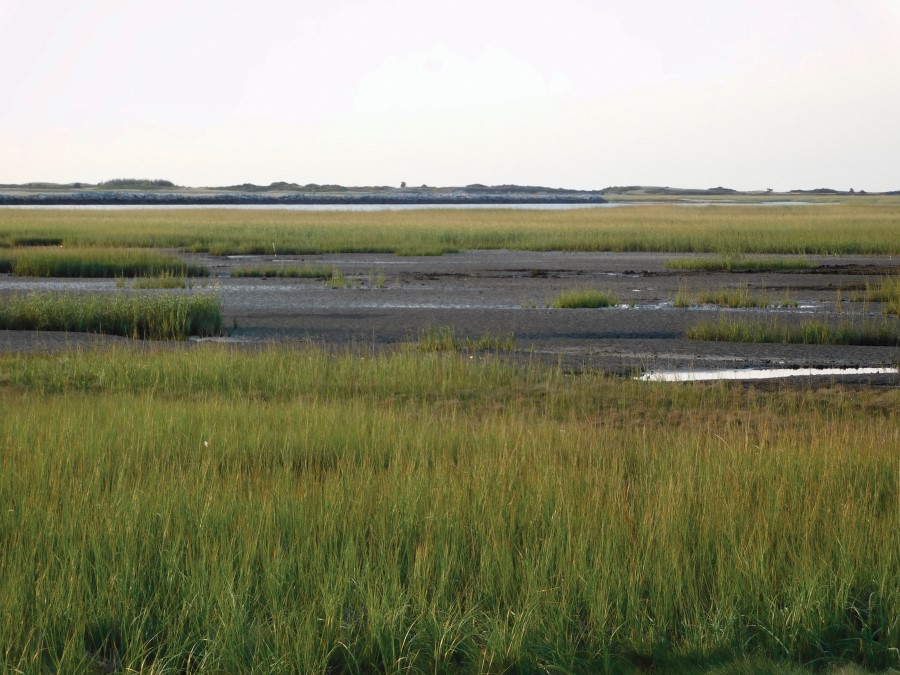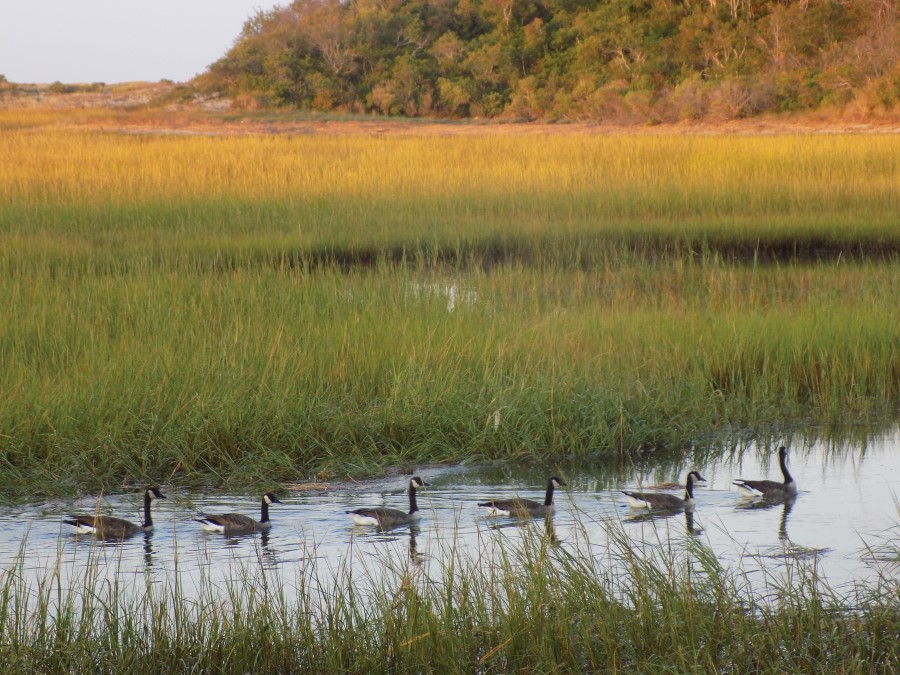PROVINCETOWN — Science and government tend to be slow-moving, but the purple marsh crab moves fast, gobbling up the spartina grass of the West End Moors.

Spartina grass holds the marsh together, its roots preventing the ground from being washed away and creating a protective buffer between sea and land. The grass is a nursery for young fish and invertebrates.
The rapid deterioration of this resource, clearly visible in expanding bald patches, is the result of the crab population which is now 10 to 20 times what it should be. Their predators, striped bass, tautog, and cunner, are prevented by the West End breakwater from entering the Moors.
A plan to stop this destruction by altering the breakwater to restore tidal flow to the marsh was proposed years ago but has been stalled for more than a year for reasons that are not entirely clear.
Stephen Smith, a plant ecologist at the Cape Cod National Seashore, has been monitoring the Moors since 2003. He’s been concerned about the crabs since at least 2014, when large denuded areas were discovered. Smith has been looking for solutions. One experiment involves laying down mesh that the crabs can’t penetrate but through which the marsh grass can grow. A second experiment involves layering sand on top of the sediment, which serves the dual purpose of raising the height of the marsh — to keep ahead of sea-level rise — and making it impossible for the crabs to build their burrows.
Smith says both experiments are yielding initial positive results but so far have been run on only a tiny scale. He hopes to scale them up this winter if state wetlands regulators agree. He will be presenting his findings later in the fall, but “it will be at least a couple of years before any large-scale restoration work could begin,” he says.
Smith’s experiments do not address a fundamental imbalance: the presence of the breakwater disrupts tidal flow and therefore the natural feeding cycle that would normally keep the crabs in check. As it stands, the purple crab has access to the spartina grass while the crab’s predators cannot get at them.
Ecologists like John Portnoy of Wellfleet see restoring tidal flow as the solution to such imbalances. Water moves freely through the breakwater, but large predators and sediment do not. “Salt marshes damaged by historic tide restrictions can, to some degree, recover simply through the re-establishment of tidal flow,” wrote Portnoy in 2006 in an article for the National Park Service. “Our management approach is to restore the marine connection, and then to allow nature to repair itself.”
Gordon Peabody, director of the consulting firm Safe Harbor Environmental Services, said, “The goal is to protect the performance of the marsh. For a marsh to be healthy, it needs full tidal flushing. We need to protect against further spartina grass loss.”

Smith said that “from an ecological perspective, we should get rid of the whole breakwater.”
But tidal flow to the Moors could be restored by creating openings in the breakwater. It was built in 1914, before there was a general understanding that a sea barrier would disrupt the complex balance of marsh life. It is now accepted wisdom that restoring the tidal flow would increase the diversity of flora and fauna, what Peabody refers to as “ecological muscle,” and protection from storm surges and flooding.
A $51,000 allocation for engineering and design work towards a dike opening was indefinitely postponed at Provincetown’s annual town meeting in 2017. The spending measure, Article 8-7, did not have the support of the harbor committee, conservation commission, or board of selectmen. A feasibility study by the Army Corps of Engineers, which was originally requested by the town in 2006, had foreseen no adverse consequences to the plan, which involved “restoring tidal flushing to the salt marsh system by breaching the dike and installing a bridge over the opening.” According to Peabody and retired National Seashore ecologist Mark Adams, the connectivity problem could also be addressed by installing a number of culverts in the dike.
Adams said that, although the study found no negative consequences, there “was the concern that the change would bring a new sediment flow that might affect aquaculture grants” to the east of the breakwater. Larry Oliver, chief of the Environmental Branch of the New England District of the Army Corps, said at a conservation commission meeting in March 2021 that in 2017 there were also concerns from swimmers and kayakers about a possible increase in the velocity of the tidal flow through an opening in the dike.
A further study to look specifically at these hydrologic issues and the potential effects of increased tidal movement on aquaculture has not been pursued by the town. In 2020, the Army Corps offered to go forward with such a study. Oliver of the Army Corps says he is still waiting to hear whether the town wants to proceed with it.
At the March 2021 meeting, town officials agreed to go forward, as former Harbormaster Rex McKinsey said, “to figure out how aquaculture sites can work within and capitalize on this idea” of opening the dike, and “to have voters’ questions answered and fears addressed” by the 2022 annual town meeting. But that did not happen.
Without the study, there can be no reassurance for the aquaculture community or for those who worry about the future of the Moors. Action on the issue continues to be postponed. At the conservation commission’s meeting on Oct. 4, Conservation Agent Tim Famulare said that a vote on the new study “just didn’t make the cut” for last April’s town meeting, but no one on the commission that night could answer the question “Why not?” A vote on the study is not on the warrant for the November special town meeting.
Provincetown Shellfish Constable Stephen Wisbauer told the Independent the question should be “Where is the evidence saying this would benefit the estuary? In my experience, there are always unintended consequences from this kind of alteration.” Mark Adams says those concerns “could be addressed by a sediment flow study and the careful placement of the breakwater culverts.”
Wisbauer said there have been past difficulties with large fish getting caught on the marsh side of the breakwater. “There is no way to create a funnel to guide the fish,” he said. Similar concerns were brought up by Chair Alfred Famiglietti of the conservation commission. Oliver countered that the fish would follow the water and find their way out.
Sediment movement from increased tidal flow was also a concern in planning the Herring River restoration project. But the Wellfleet Shellfish Advisory Board, despite initial fears, ultimately voted unanimously for the project, writing to the select board: “We believe the science is in, and the ecological, economic, and social benefits of restoring a more robust tidal flow … make proceeding with this ambitious project the proper course of action.”
Smith said that Provincetown and Truro have “already had two major marsh restoration successes, at Hatches Harbor and East Harbor.” Opening up the sea barrier was key to both projects, allowing fuller tidal flushing and enabling the return of native flora and fauna. Both projects have controls over the flow so that the effects can be carefully monitored.
“These projects have been successful,” said Adams, “but the public process is painfully slow and has benefited from the volunteer efforts of citizen groups and scientists who have no stake in the project except restoring nature’s processes. These efforts are among the best things we can do to respond to climate change, by allowing nature to do its work unimpeded.”
Editor’s note: An earlier version of this article, published in print on Oct. 20, incorrectly named the U.S. Fish and Wildlife Service instead of the National Park Service as the agency for which ecologist John Portnoy wrote about salt marsh restoration.



